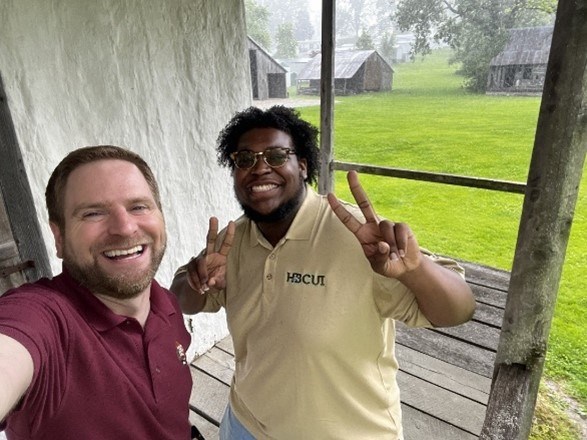Last updated: March 7, 2023
Article
Staff Spotlight: Mykel King

NPS Photo
Following his studies at Benedict College, he planned to go to law school. However, when he was told that he would not be allowed to hold a job during the first year of his legal studies due to the intensity of the courses, he made the difficult decision to delay his plans for law school to sometime in the future. His friend shared how she would be interning with the Greening Youth Foundation as an Education and Interpretation Intern with the National Park Service, so he decided to take a chance and send his resume even though he did not have specific prior experience. He did not know what to expect and was delighted when he heard he had been selected. He ended up taking on two internships over two summers and earned his Public Land Corps Hiring Authority. He is now a Park Guide at the Charles Young Buffalo Soldiers National Monument.

NPS Photo
King did not know who he was going to meet on any given day, between the visitors who came from France, Canada, and Germany and the NPS staff and interns. He recalls one day when he was invited to a park employee’s house.
“I remember being invited over for dinner. I got to the house and this woman was making spaghetti. It was not until after we started talking about what we wanted to do with our careers and what our next steps were that I realized she worked for the National Park Service. She wasn’t wearing her uniform. I saw her in a different light, where she was with her family. We sat at the table, and she served the best spaghetti I had ever had with the bay leaves and all.”

NPS Photo
A story that particularly intrigued him was the Bauvais-Amoureux House. This house is one of only three known surviving poteaux-en-terre style houses in Ste. Geneviève. It was originally built in 1792 by Jean Baptiste, the son of one of the first residents of Ste. Geneviève. Pélagie Amoureux, originally Pélagie Vital, was enslaved for the first 27 years of her life. During this time, she met a White Frenchman named Benjamin Amoureux and fell in love with him. Around 1830, Benjamin and Pélagie rowed across the Mississippi to Illinois where they could be married by a Catholic priest. They returned to Ste. Geneviève where they presented their marriage certificate and took communion. She continued to be enslaved by the Bauvais family, along with her son Félix, for the first few years of her marriage. They were eventually emancipated by Félicité Bauvais, the widow of Vital St. Gemme Bauvais, in 1832. From 1832 to 1852, they lived apart until they bought the Bauvais-Amoureux house. Their descendants continued to live there until 1923.

NPS Photo
He would go to the Circuit Clerks Office and search through records to find stories of the enslaved people in Ste. Geneviève. Many of these records have not been digitized, so in many cases, he was looking at the original records, which put a smile on his face. He felt closer to this history.“I originally went to look for one station and found four or five. I went to the city library first to get more information…I talked to librarians. Some of them were working with the Randolph County Genealogy Society. Many of these people weren’t being talked about because helping enslaved people was illegal back then.”
To stay away from the heat and small office in the park’s attic during his second internship, he found himself spending large chunks of his time in the library, which was at the community center. He met many of the community leaders here. It became his second home where he would read for hours and take in all the history that had been documented on paper. He would discuss how the park would fit in within the community and what the community wanted to see from the park.

NPS Photo
After spending two summers with Ste. Geneviève, it was time for a change. He traded the hot, sweaty summers of Missouri for cold, snowy winters of Ohio. In November 2022, he became a Park Guide at the Charles Young Buffalo Soldier National Historic Monument.
King knew Brigadier General Charles Young was one of the Buffalo Soldiers of the 9th and 10th Cavalries as well as the first Black Superintendent of the National Park Service at Sequoia National Park. He also knew Young was the third African-American graduate of the United States Military. However, he was intrigued to learn of the other aspects of Young’s life that is not always shared widely. Given his background in the arts, King felt an immediate connection to Young’s interest in the arts. Young was a teacher and also wrote over 100 poems and a couple of songs “To see him doing all of that while maintaining a career is impressive,” he noted.

NPS Photo Public Domain
He has found a way to bridge his passion for music and the performing arts into the work he does. He has a deep love for music and singing keeps him motivated and fulfilled. When he was younger, he was in the Georgia All-State Choir, the Central High School Glee club, a group called Destined for Greatness, and regularly sang at his church in Macon, as well as in Concert and Gospel choirs while attending Benedict College. He decided to become a member of Alpha Rho Theta Fraternity of the Creative and Performing Arts to serve the community through art. Some of his favorite parks include Ocmulgee Mounds National Historical Park, Great Smoky Mountains National Park, Martin Luther King Jr. National Historical Park, and Ste. Geneviève National Historic Park. If he could create his own park, it would be for Dr. Betty Johnson Tolbert, an educator from Macon, Georgia, who has touched and inspired generations in the area.
